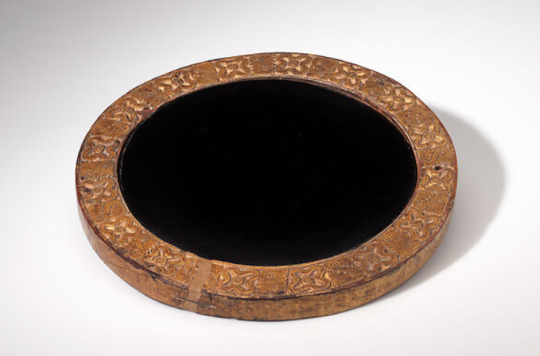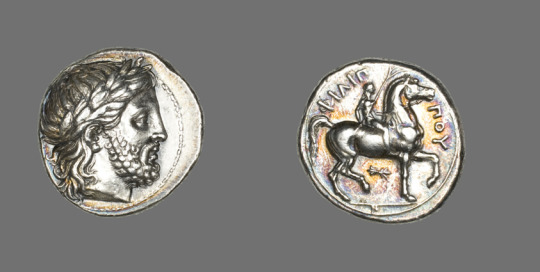Note
Hello, do you have any photos of ancient Irish or Swiss masks or costumes?
sorry for the late response, i've been busy. But i will try to find some as soon as i can.
13 notes
·
View notes
Text

Effigy Vessel
Jama Coaque
300 BCE-600 CE
The Jama-Coaque culture of Ecuador’s northern coast is known for complex moldmade and hand-modeled ceramic sculptures that depict people and animals. Felines are the most frequently represented animal, indicating their importance as symbols of power. On this modeled effigy vessel, the large jar on the jaguar’s back suggests that the object was ceremonial, perhaps used for ritual offerings. The style of the round, bulging eyes and nose indicates that the jaguar represents a supernatural being.
source
162 notes
·
View notes
Text

Pendant in the Form of a Spider
Chiriquí
1000-1500
In Costa Rica gold animal pendants were often worn by and buried with elite members of Chiriquí society. The eagle’s broad tail and outstretched wings may symbolize the animal’s ability to soar high into the sky and enter the supernatural realm. The spider’s legs end in human hands, which hold a double-headed snake. The abdomen, adorned with a bird and two crocodilian heads, is a bell that would have made a tinkling sound as the wearer moved. Depictions of predatory animals would have inspired awe and respect and provided the wearer with power and protection.
source
137 notes
·
View notes
Text

Double Pendant in the Form of a Mythical Saurian with Tusks
Coclé
800-1200
Emblems of caiman and caiman-like creatures were often symbolic of the land floating in the primordial sea, thus evoking the original world creation and the ongoing ties between the mythic past and the heroic present.
source
175 notes
·
View notes
Text

Tripod Incense Burner (Censer) with Peony-Leaf Scrolls, Netlike Petals, and Masklike Legs
China, Northern Song (960–1127) or Jin dynasty (1115–1234), c. 12th century
171 notes
·
View notes
Text

Maskette
Mexican, 1200-900 BC (Early Formative)
88 notes
·
View notes
Text

Pair of Earflares
Olmec
10th–4th century BCE
source
63 notes
·
View notes
Text

Carved Bowl with Olmec Dragon Motif
Olmec, Mexico, 1200-900 BCE (Early Pre-Classic)
The apparently simple, non-figurative design actually shows an abstracted image of a mythical creature known as the “Olmec dragon.” It combined features of different powerful predators of the region, including the harpy eagle, crocodile, and jaguar. The horizontal and vertical lines here show the fast-moving body and tufted eyebrows of this creature. The red pigment here is the mercury compound cinnabar, brought from sources hundreds of miles away.
44 notes
·
View notes
Text

Bowl with Fish
China, Jin dynasty (1115–1234) or later
375 notes
·
View notes
Text

Plate with an Image of a Moth
Huaxtec, Mexico, 900–1200
120 notes
·
View notes
Text

Obsidian Mirror
Aztec
1200-1521 CE (mirror) 16th century (frame)
Obsidian, a volcanic glass, was used to make cutting tools as well as delicate ornaments. It was valued for its reflective qualities and employed in the form of mirrors for divining. Such mirrors were associated with powerful rulers and divinities: the name of a major Aztec god, Tezcatlipoca, means "smoking mirror." The gilded wood frame of this example likely dates to the colonial period and is carved with alternating flower and step-fret symbols.
source
387 notes
·
View notes
Text

Turkey Vessel
Veracruz
7th–10th century
In ancient Veracruz and elsewhere in Mesoamerica, turkeys were not just nutritionally important resource animals—they were also esteemed by high-ranking people for ceremonial use. For example, scholars have interpreted images in the Dresden Codex, the oldest of the few Maya manuscripts that still exist, as depicting priests offering sacrificial turkeys to deities to ensure agricultural fertility. Archaeologists have also uncovered turkey bones throughout ancient Mesoamerica in ancient high-status burials and caches as well as in domestic contexts of both elites and commoners. Even today, turkeys are widely raised in backyards in rural Mexico, their esteem maintained in some areas through ritual activities and gift exchanges that echo practices of the past.
source
74 notes
·
View notes
Text

Tetradrachm (Coin) Depicting the God Zeus
Greek, Reign of Phillip II (359–336 BCE)
The official record of quadrennial games honoring the supreme Greek god Zeus at a sanctuary dedicated to him at Olympia began in 776 BCE. With few interruptions, they took place every four years for about 1,100 years. In 394, CE the Christian emperor Theodosius I (reigned 379–95) abolished them as pagan rites. The most prestigious competition remained the footrace, but eventually it was supplanted in popularity by the horse races. Horses were symbols of socioeconomic status, since only the privileged could afford to buy, feed, and train them and transport their teams and trainers to Olympia every four years. In time, many of the victors in the horse races included kings and tyrants. Philip II, king of Macedon, who minted this coin, owned the horse that won the race in Olympia in 356 BCE. The same year his son was born; he would grow up to become Alexander the Great (356–332 BCE). The head of Zeus on the front referred to Philip’s claim that his family descended from the god. On the back Philip commemorated his victory in the horse races of the Olympic Games with an image of a jockey astride his mount.
164 notes
·
View notes
Text

Head from a Figurine of a Female
Java, Indonesia, 14th/15th century
38 notes
·
View notes
Text


Scarab with Wish Formula
Egyptian, ca. 1186-736 BCE (Late New Kingdom-Third Intermediate Period)
This scarab has a bottom inscription, which is framed by an oval line. It is contains a wish formula, which focuses on the young recruits in the army group under the name of the god Seth. The Seth-hieroglyph is the most dominant sign in the whole inscription. The scarab is longitudinally pierced, was originally mounted or threaded, and served as an amulet with a special blessing for young soldiers. The scarab should secure the support and protection of the powerful god Seth for the young recruits of the army. It is also possible that the phrase was used as a name for a military group of recruits. Seth and his powerful protection became popular during the Ramesside Period, and it is understandable that especially the young recruits of the army needed his special protection.
49 notes
·
View notes
Text

Deer-shaped vessel
Chimú
1350–1470 CE
Animal-shaped vessels were made on Peru's northern coast from the second millennium B.C. to the time of the conquest. This deer vessel, fabricated when metal production in Peru had reached its peak, displays the naturalism that characterized similar works in ceramic created by earlier cultures. It is made of many separately shaped pieces of sheet silver joined by soldering.
source
78 notes
·
View notes
